设备期望属性的应用
设备期望属性的应用
在物联网解决方案中,下发属性时如果设备不在线会导致下发失败。如果想要更优雅和高效的完成属性的下发呢?平台提供设置期望属性值功能,通过缓存设备属性的期望值,实现从物联网平台云端控制设备属性值。
本文介绍设置期望属性值,实现从物联网平台控制灯泡状态的相关操作。
场景信息
开关设备接入物联网平台后,若需从物联网平台控制灯泡工作状态(1:打开;0:关闭),需要灯泡一直保持连网在线。实际情况下,灯泡可能无法一直在线。
您可在物联网平台设置设备期望属性值,使其存储在物联网平台云端。设备在线后,可读取物联网平台存储的期望属性值,来更新自身属性值。然后,设备会将更新后的属性值上报至物联网平台。

整体流程
1.创建产品和设备
2.使用Postman模拟设备
3.设置和获取期望属性
4.设备端开发
创建产品和设备
进入Tuya物联网平台阿里云计算巢。
在服务实例页签的全托管服务下,找到对应的实例,单击实例卡片。
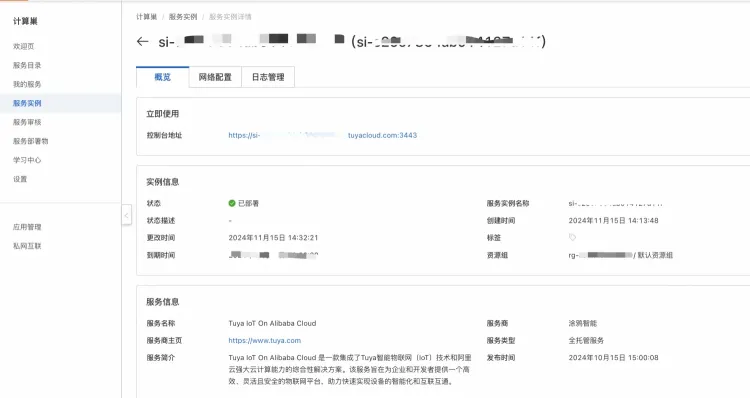
在左侧导航栏,选择产品开发 > 产品,单击创建产品,创建一个产品:灯泡测试。
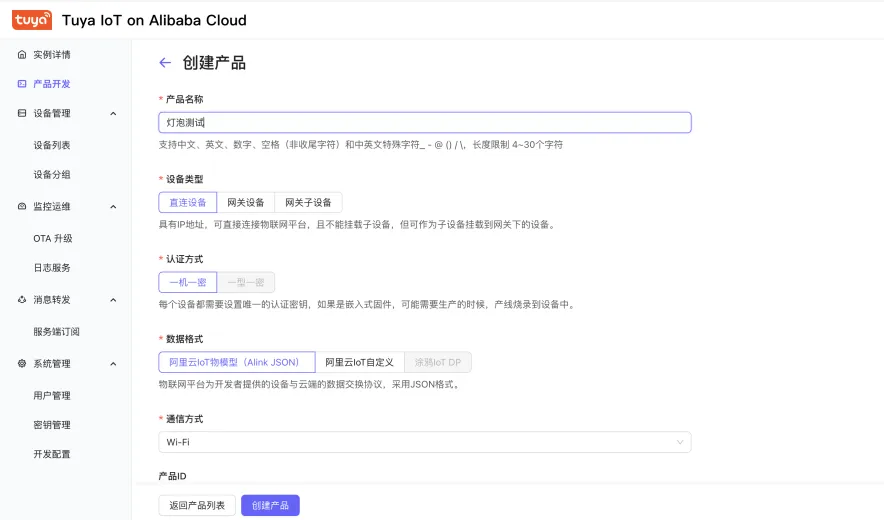
产品创建成功后,单击继续开发前往功能定义,为产品添加自定义功能并发布。如图所示,本示例添加属性工作状态(LightStatus)。
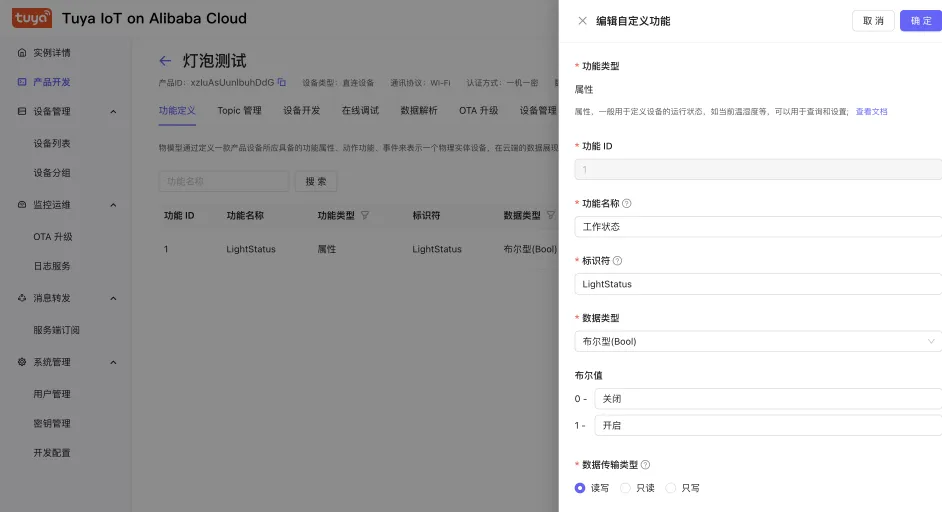
在左侧导航栏,选择设备管理 > 设备列表,单击添加设备,在灯泡产品下添加设备:LampTest。设备添加成功后,获取设备证书信息(ProductKey、DeviceName和DeviceSecret)。
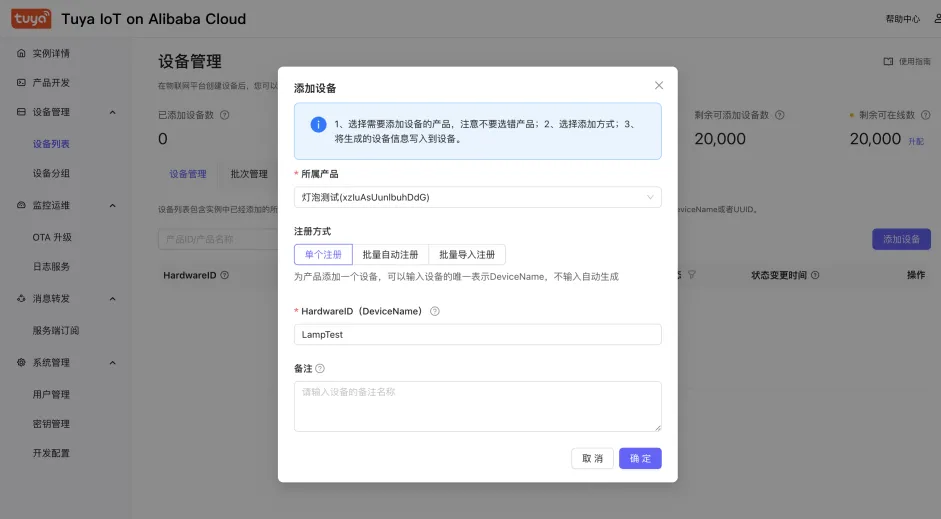
您可在设备列表,单击设备LampTest对应的查看进入设备详情页面,查看运行状态和连接参数
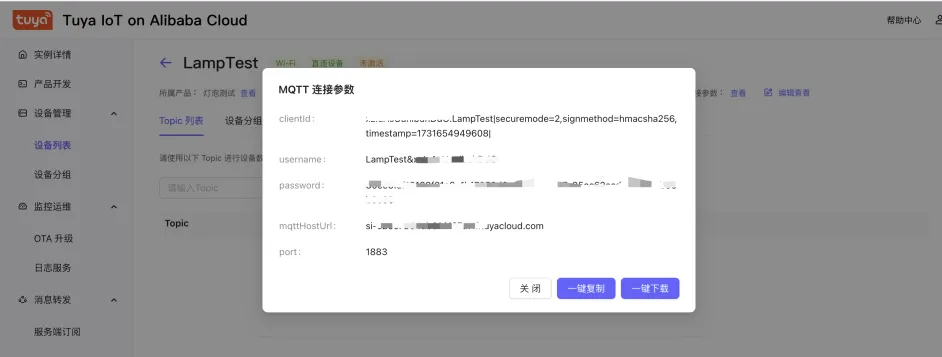
使用Postman模拟设备
1.您可携带MQTT连接参数在Postman创建对应的MQTT连接,具体步骤可以参考使用Postman模拟设备。
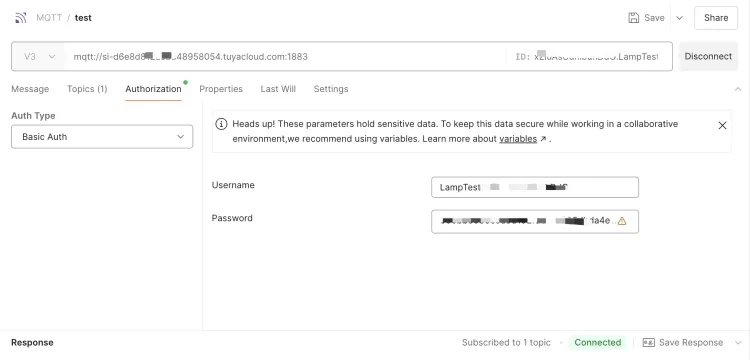
2.完成对/sys/${productKey}/${deviceName}/thing/service/property/set下发属性topic的订阅

设置和获取期望属性值
您可通过平台提供的Java签名示例代码生成URL语法后调用物联网平台云端API,设置设备期望属性值。
1.在示例代码OpenAPISignatureDemo类中找到对应的代码块,完成对SetDeviceDesiredProperty方法参数的替换。
//方法二:已经有参数Map,使用参数进行签名
Map<String, String> map = new HashMap<String, String>();
// 公共参数
map.put("AccessKeyId", accessKey);
map.put("SignatureMethod", "HMAC-SHA1");
map.put("Timestamp", formattedDateTime);
map.put("SignatureNonce", signatureOnce);
// 接口请求参数
map.put("Action", "SetDeviceDesiredProperty");
map.put("Versions", "{}");
map.put("Items", "{\"LightStatus\":13}");
map.put("ProductKey", "xZluAsUunlbuhDdG");
map.put("DeviceName", "LampTest");
try {
String signature = SignatureUtils.generate(httpMethod, map, secretKey);
System.out.println("[方法二:开始生成]======根据参数生成签名,并且生成curl命令");
System.out.println("curl " + "'" + host+"/?"+buildQueryParam(map) + "&Signature=" + signature + "'");
} catch (Exception e) {
System.out.println("生成签名失败"+e.getMessage());
e.printStackTrace();
}执行后会得到如下URL语法请求
curl 'https://si-d6e8d812acb848958054.tuyacloud.com:8686/?Action=SetDeviceDesiredProperty&Versions=%7B%7D&SignatureNonce=c653621a65e444b18786e0f096e92b72&AccessKeyId=xMr9wgwXQLhv5AUa65o03mcD&SignatureMethod=HMAC-SHA1&Items=%7B%22LightStatus%22%3A1%7D&Timestamp=2024-11-19T10%3A24%3A29Z&ProductKey=xZluAsUunlbuhDdG&DeviceName=LampTest&Signature=d3RCeZ%2FSk2orvOn8XHzVn3jh8NM%3D'设备在线时,设备监听/sys/${productKey}/${deviceName}/thing/service/property/set可以直接收到设置的属性
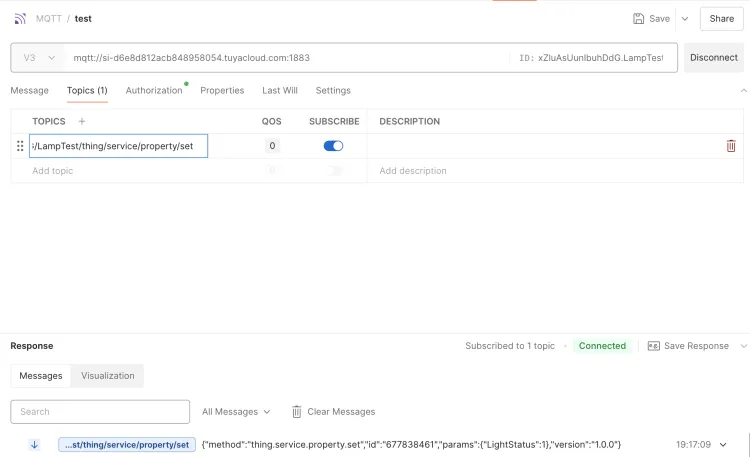
设备离线时,设备无法收到消息,在设备上线后通过对/sys/${productKey}/${deviceName}/thing/property/desired/get推送对应的上行消息,
对/sys/${productKey}/${deviceName}/thing/property/desired/get_reply完成订阅,可以获取最新的期望属性。具体消息格式可参考设备期望属性值
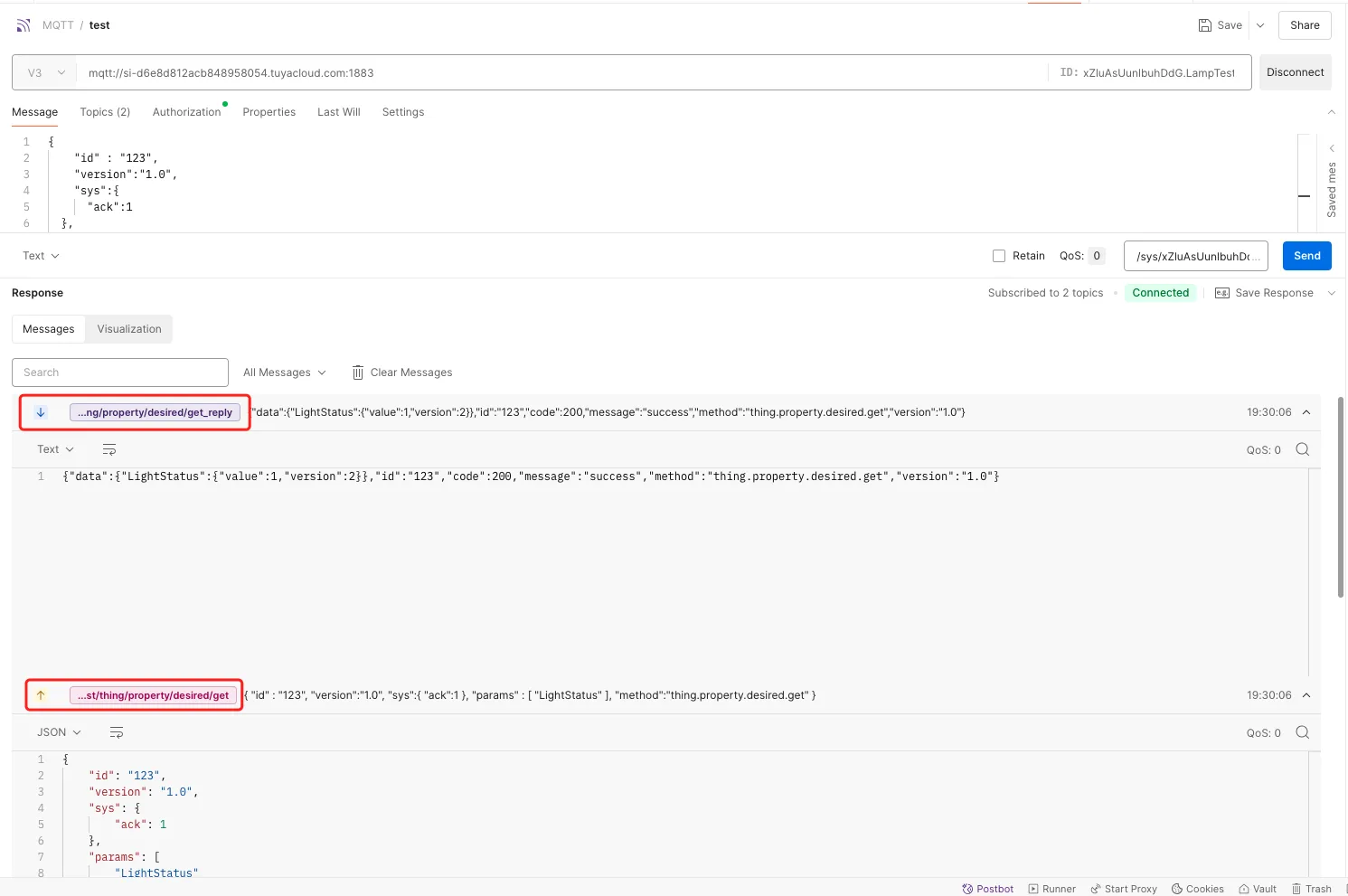
设备端开发
设备获取期望属性值,有两种场景:
灯泡重新上线时,主动获取物联网平台云端缓存的期望属性值。
灯泡正处于上线状态,实时接收物联网平台云端推送的期望属性值。
设备端开发更多信息,请参见使用设备端SDK接入。
本文以Java 代码为例,提供了设备端Demo示例,请参见下文附录:设备端Demo代码。
填入设备证书、地域和MQTT接入地址的信息。
/**
* 设备证书信息
*/
private static String productKey = "******";
private static String deviceName = "********";
private static String deviceSecret = "**************";
/**
* MQTT连接信息
*/
private static String regionId = "******";
private static String iotInstanceId = "si-*************";
......
/**
* 设置 Mqtt 初始化参数
*/
config.channelHost = iotInstanceId + ".aliyun.tuyacloud.com:1883";2.添加以下方法,用于变更实际灯泡的属性,并在属性变更后,主动将信息上报到最新属性值中。
/**
* 真实设备处理属性变更时,在以下两个场下会被调用:
* 场景1. 设备联网后主动获取最新的属性期望值(由设备发起,拉模式)
* 场景2. 设备在线时接收到云端property.set推送的属性期望值(由云端发起,推模式)
* @param identifier 属性标识符
* @param value 期望属性值
* @param needReport 是否通过property.post发送状态上报。
* 上面场景2的处理函数中已集成属性上报能力,会将needReport设置为false
* @return
*/
private boolean handlePropertySet(String identifier, ValueWrapper value, boolean needReport) {
ALog.d(TAG, "真实设备处理属性变更 = [" + identifier + "], value = [" + value + "]");
// 用户根据实际情况判性是否设置成功,这里测试直接返回成功
boolean success = true;
if (needReport) {
reportProperty(identifier, value);
}
return success;
}
private void reportProperty(String identifier, ValueWrapper value){
if (StringUtils.isEmptyString(identifier) || value == null) {
return;
}
ALog.d(TAG, "上报属性identity=" + identifier);
Map<String, ValueWrapper> reportData = new HashMap<>();
reportData.put(identifier, value);
LinkKit.getInstance().getDeviceThing().thingPropertyPost(reportData, new IPublishResourceListener() {
public void onSuccess(String s, Object o) {
// 属性上报成功
ALog.d(TAG, "上报成功 onSuccess() called with: s = [" + s + "], o = [" + o + "]");
}
public void onError(String s, AError aError) {
// 属性上报失败
ALog.d(TAG, "上报失败onError() called with: s = [" + s + "], aError = [" + JSON.toJSONString(aError) + "]");
}
});
}3.灯泡在线时,如果物联网平台设置了灯泡的期望属性值,该值将被推送到设备端。灯泡处理消息,改变属性状态。
如下代码中,将调用connectNotifyListener处理消息,相关Alink协议说明,请参见设备上报属性。
收到异步下行的数据后,mCommonHandler被调用,进而调用handlePropertySet更新设备的物理属性。
/**
* 注册服务调用(以及属性设置)的响应函数。
* 云端调用设备的某项服务的时候,设备端需要响应该服务并回复。
*/
public void connectNotifyListener() {
List<Service> serviceList = LinkKit.getInstance().getDeviceThing().getServices();
for (int i = 0; serviceList != null && i < serviceList.size(); i++) {
Service service = serviceList.get(i);
LinkKit.getInstance().getDeviceThing().setServiceHandler(service.getIdentifier(), mCommonHandler);
}
}
private ITResRequestHandler mCommonHandler = new ITResRequestHandler() {
public void onProcess(String serviceIdentifier, Object result, ITResResponseCallback itResResponseCallback) {
ALog.d(TAG, "onProcess() called with: s = [" + serviceIdentifier + "]," +
" o = [" + result + "], itResResponseCallback = [" + itResResponseCallback + "]");
ALog.d(TAG, "收到云端异步服务调用 " + serviceIdentifier);
try {
if (SERVICE_SET.equals(serviceIdentifier)) {
Map<String, ValueWrapper> data = (Map<String, ValueWrapper>)((InputParams)result).getData();
ALog.d(TAG, "收到异步下行数据 " + data);
// 设置真实设备的属性,然后上报设置完成的属性值
boolean isSetPropertySuccess =
handlePropertySet("LightStatus", data.get("LightStatus"), false);
if (isSetPropertySuccess) {
if (result instanceof InputParams) {
// 响应云端,接收数据成功
itResResponseCallback.onComplete(serviceIdentifier, null, null);
} else {
itResResponseCallback.onComplete(serviceIdentifier, null, null);
}
} else {
AError error = new AError();
error.setCode(100);
error.setMsg("setPropertyFailed.");
itResResponseCallback.onComplete(serviceIdentifier, new ErrorInfo(error), null);
}
} else if (SERVICE_GET.equals(serviceIdentifier)) {
} else {
// 根据不同的服务做不同的处理,跟具体的服务有关系
ALog.d(TAG, "根据真实的服务返回服务的值,请参照set示例");
OutputParams outputParams = new OutputParams();
// outputParams.put("op", new ValueWrapper.IntValueWrapper(20));
itResResponseCallback.onComplete(serviceIdentifier, null, outputParams);
}
} catch (Exception e) {
e.printStackTrace();
ALog.d(TAG, "云端返回数据格式异常");
}
}
public void onSuccess(Object o, OutputParams outputParams) {
ALog.d(TAG, "onSuccess() called with: o = [" + o + "], outputParams = [" + outputParams + "]");
ALog.d(TAG, "注册服务成功");
}
public void onFail(Object o, ErrorInfo errorInfo) {
ALog.d(TAG, "onFail() called with: o = [" + o + "], errorInfo = [" + errorInfo + "]");
ALog.d(TAG, "注册服务失败");
}
};4.灯泡离线后,如果物联网平台云端设置了灯的期望属性值,该值将被存储在云端。
灯泡上线后,会主动获取期望属性值,然后调用handlePropertySet更新实际设备的属性。
LinkKit.getInstance().init(params, new ILinkKitConnectListener() {
public void onError(AError aError) {
ALog.e(TAG, "Init Error error=" + aError);
}
public void onInitDone(InitResult initResult) {
ALog.i(TAG, "onInitDone result=" + initResult);
connectNotifyListener();
// 获取云端最新期望属性值
getDesiredProperty(deviceInfo, Arrays.asList("LightStatus"), new IConnectSendListener() {
public void onResponse(ARequest aRequest, AResponse aResponse) {
if(aRequest instanceof MqttPublishRequest && aResponse.data != null) {
JSONObject jsonObject = JSONObject.parseObject(aResponse.data.toString());
ALog.i(TAG, "onResponse result=" + jsonObject);
JSONObject dataObj = jsonObject.getJSONObject("data");
if (dataObj != null) {
if (dataObj.getJSONObject("LightStatus") == null) {
// 未设置期望值
} else {
Integer value = dataObj.getJSONObject("LightStatus").getInteger("value");
handlePropertySet("LightStatus", new ValueWrapper.IntValueWrapper(value), true);
}
}
}
}
public void onFailure(ARequest aRequest, AError aError) {
ALog.d(TAG, "onFailure() called with: aRequest = [" + aRequest + "], aError = [" + aError + "]");
}
});
}
});
private void getDesiredProperty(BaseInfo info, List<String> properties, IConnectSendListener listener) {
ALog.d(TAG, "getDesiredProperty() called with: info = [" + info + "], listener = [" + listener + "]");
if(info != null && !StringUtils.isEmptyString(info.productKey) && !StringUtils.isEmptyString(info.deviceName)) {
MqttPublishRequest request = new MqttPublishRequest();
request.topic = DESIRED_PROPERTY_GET.replace("{productKey}", info.productKey).replace("{deviceName}", info.deviceName);
request.replyTopic = DESIRED_PROPERTY_GET_REPLY.replace("{productKey}", info.productKey).replace("{deviceName}", info.deviceName);
request.isRPC = true;
RequestModel<List<String>> model = new RequestModel<>();
model.id = String.valueOf(IDGeneraterUtils.getId());
model.method = METHOD_GET_DESIRED_PROPERTY;
model.params = properties;
model.version = "1.0";
request.payloadObj = model.toString();
ALog.d(TAG, "getDesiredProperty: payloadObj=" + request.payloadObj);
ConnectSDK.getInstance().send(request, listener);
} else {
ALog.w(TAG, "getDesiredProperty failed, baseInfo Empty.");
if(listener != null) {
AError error = new AError();
error.setMsg("BaseInfoEmpty.");
listener.onFailure(null, error);
}
}
}